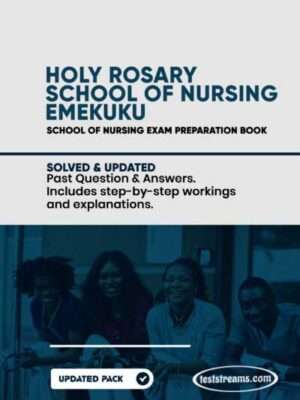Description
Benue State School of Nursing Makurdi, Past Questions And Answers
Are you determined to secure your spot at the prestigious Benue State School of Nursing? Do you want to maximize your chances of success in the entrance exams and stand out from the crowd? Look no further! Our comprehensive Benue State School of Nursing Past Questions and Answers package is your key to acing the entrance exams with confidence!
About Benue State School Of Nursing Makurdi
Are you ready to embark on a fulfilling and rewarding career in nursing? Look no further than the prestigious Benue State School of Nursing! We take immense pride in being a beacon of excellence in nursing education, dedicated to nurturing compassionate, skilled, and confident healthcare professionals who will make a significant impact on the health and well-being of individuals and communities.
Why Choose Benue State School of Nursing?
- Exceptional Education: Our school is renowned for providing an exceptional education that lays a strong foundation for a successful nursing career. Our comprehensive curriculum, developed in line with the latest healthcare advancements, equips students with the knowledge and skills needed to excel in their profession.
- Experienced Faculty: At Benue State School of Nursing, we believe in learning from the best. Our faculty comprises experienced nursing professionals who are committed to sharing their expertise and wisdom with aspiring nurses. They provide personalized attention, mentorship, and guidance to every student.
- State-of-the-Art Facilities: Our campus boasts state-of-the-art facilities, including fully equipped laboratories, simulation centers, and modern classrooms. These cutting-edge resources ensure that our students gain hands-on experience and exposure to real-world healthcare scenarios.
Samples of Benue State School of Nursing Makurdi, Past Questions And Answers
1. Which of the following best defines “kinematics” in physics?
A.The study of forces and their effects on motion
B.The study of the relationship between matter and energy
C.The study of motion without considering its causes
D.The study of properties and behavior of matter
2. A car travels from point A to point B in a straight line. If the initial velocity is 30 m/s, and it accelerates at a rate of 2 m/s², what is its velocity at point B, located 100 meters away from point A?
A.40 m/s
B.50 m/s
C.60 m/s
D.70 m/s
3. Which of Newton’s laws states that “an object at rest will remain at rest, and an object in motion will remain in motion with a constant velocity unless acted upon by an external force”?
A.Newton’s First Law
B.Newton’s Second Law
C.Newton’s Third Law
D.Law of Universal Gravitation
4. What is the weight of a 50 kg mass on the surface of the Earth? (Take acceleration due to gravity as 9.8 m/s²)
A.490 N
B.50 N
C.500 N
D.5 N
5. If a convex lens has a focal length of +20 cm, what type of lens is it, and what is its nature of image formation?
A.Convex lens, real and inverted image
B.Convex lens, virtual and upright image
C.Concave lens, real and upright image
D.Concave lens, virtual and inverted image
6. An electric current of 2 amperes flows through a resistor with a resistance of 5 ohms. What is the voltage across the resistor?
A.2 V
B.5 V
C.10 V
D.20 V
7.Which type of electromagnetic waves has the shortest wavelength?
A.Radio waves
B.Microwaves
C.X-rays
D.Gamma rays
8. When white light passes through a prism, it separates into different colors due to a phenomenon known as:
A.Reflection
B.Dispersion
C.Refraction
D.Diffraction
BIOLOGY
1. What is the primary function of the respiratory system?
A.Transporting nutrients and gases throughout the body
B.Providing structural support and protection to the body
C.Regulating body temperature and fluid balance
D.Facilitating the exchange of gases between the body and the environment
2.Which of the following is the smallest unit of life capable of carrying out all the functions of an organism?
A.Tissue
B.Organ
C.Cell
D.Organism
3. What is the process by which plants convert light energy into chemical energy in the form of glucose?
A.Photosynthesis
B.Respiration
C.Transpiration
D.Digestion
4. Which of the following is a function of the circulatory system?
A.Producing hormones for body regulation
B.Breaking down food and absorbing nutrients
C.Providing support and protection for the body
D.Transporting oxygen and nutrients to cells and removing waste products
5. What is the role of the red blood cells in the human body?
A.Carrying oxygen to body cells
B.Fighting infections and diseases
C.Producing hormones for blood sugar regulation
D.Assisting in the digestion of food
6. The process of cell division, which results in two identical daughter cells, is called:
A.Mitosis
B.Meiosis
C.Fertilization
D.Replication
7. Which of the following is responsible for carrying genetic information in the form of genes?
A.Proteins
B.Carbohydrates
C.Nucleic acids
D.Lipids
8. Which of the following is a function of the nervous system?
A.Regulating the body’s metabolism
B.Producing and secreting hormones
C.Coordinating and transmitting signals within the body
D.Providing structural support and protection











Reviews
There are no reviews yet.